How to Say No In Korean? Sometimes, No Means Yes and Yes Means No... 🤯
Unlock the Secrets of Native-Sounding Korean // the Art of Saying No
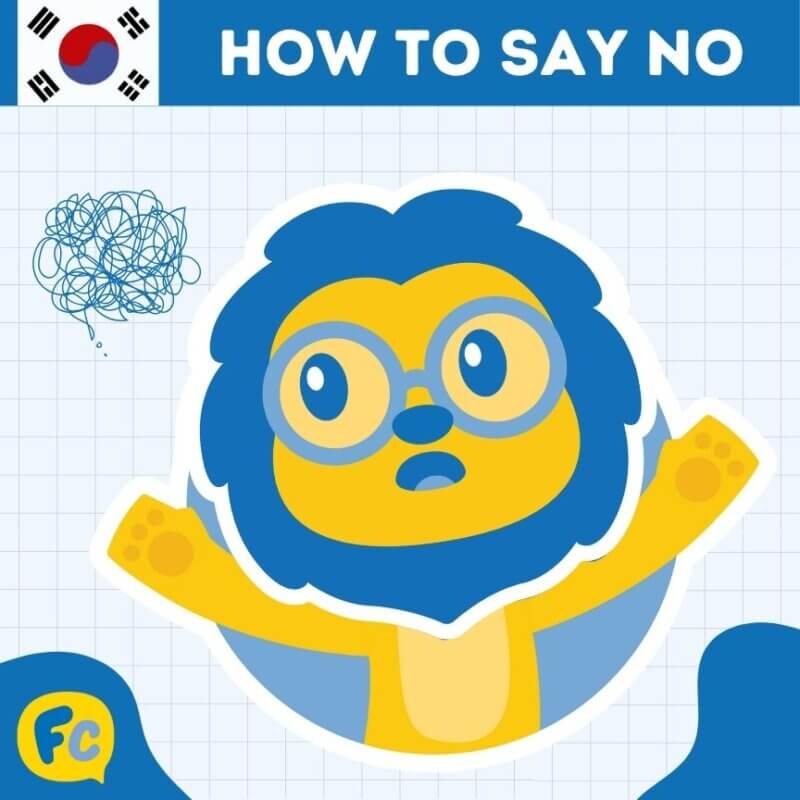
👉Here is an interesting topic of discussion, saying no in Korean.
To begin with, the concept of no isn’t as simple because Koreans prefer not to be blunt and reject you straight away as this might sound disrespectful.
Second, sometimes no can mean yes, and yes can mean no. Yeah. You read that right.
Lastly, there are polite ways Koreans reject or decline a request without directly saying no. This might sound complicated, but it isn’t that difficult either.
Read along to understand some tips and tricks so you remember
when and how to use them.
Let’s discover how to express “NO” in Korean!
⬇️ Interested in one of the contents below? Clicking on the link will bring you to your preferred section!
No in Korean | Formal and Informal Ways to Say No
No in Korean | Difference between 아니요 vs 아니에요
No in Korean | Answering Negative Questions in Korean
No in Korean | Alternative Ways to Say No
No in Korean | FAQ
No in Korean | Formal and Informal Ways to Say No
No is one of the most used words in our daily lives. You most definitely heard one of the ‘no’ we are going to discuss below in a K-drama or K-pop song.
After this lesson, we hope you will become more familiar with how native speakers say no.
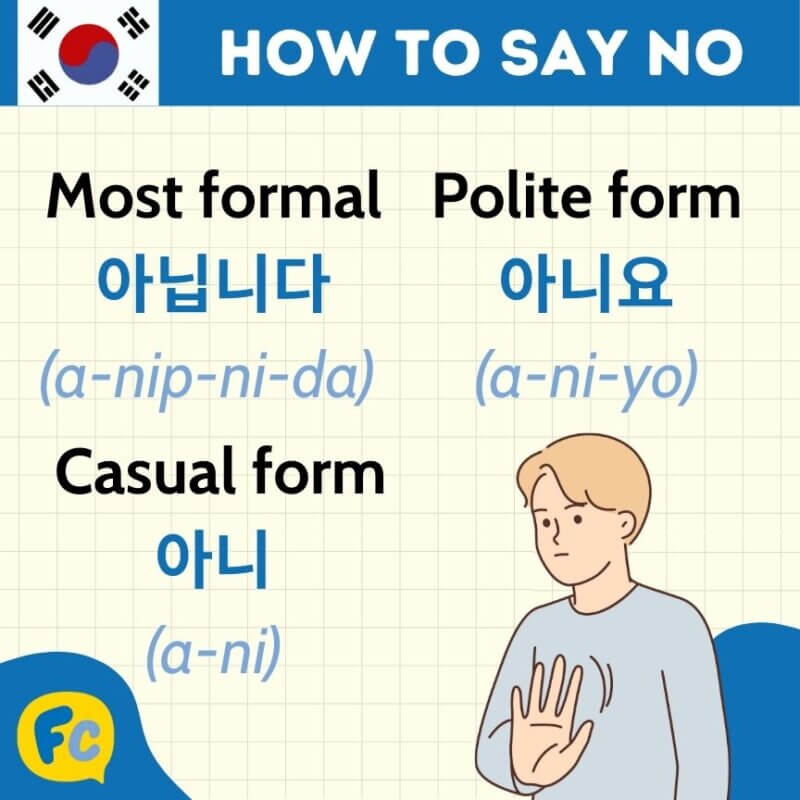
아닙니다 (a-nip-ni-da) – Most formal
👉 The most formal way to say no is 아닙니다 (a-nip-ni-da). You would only use this for a very serious situation like during a corporate interview, giving a speech, or in the military.
학생입니까?
(hak-seang-ip-ni-kka)You can answer by saying below:
아닙니다.
(a-nip-ni-da)Or
학생이 아닙니다.
(hak-seang-yi a-nip-ni-da)아니요 (a-ni-yo) – Polite form
👉 This would be the most common way to say no. This is also formal which makes it easier to use in any situation. It’s like the go-to word you put in your dictionary for those ‘not sure which one to use’ moments.
Let’s look at some examples below.
Example 1:
잘 잤어요?
(jal-ja-sseo-yo)아니요, 잘 못 잤어요.
(a-ni-yo jal mot ja-sseo-yo)Example 2:
밥 먹었어요?
(bab-mo-go-sseo-yo)아니요, 아직 안 먹었어요
(a-ni-yo a-jik an mo-go-sseo-yo)아니 (a-ni) – Casual form
👉 The shortest and most casual way to say no is 아니 (a-ni). This is used for your close circle of friends, siblings, or people younger than you.
Example 1:
잘 잤어?
(jal ja-sseo)아니 잘 못 잤어.
(a-ni jal mot-ja-sseo)Example 2:
밥 먹었어?
(bab mo-go-sseo)아니, 아직 안 먹었어.
(a-ni a-jik an mo-go-sseo)
63 Korean Words You Never Knew You Knew!
Did you know you already know loads of Korean words and that’s thanks to the inclusion of Korean Loanwords in the language. Here’s our favourites.
No in Korean | Difference between 아니요 (a-ni-yo) vs 아니에요 (a-ni-e-yo)
👉 Although both are forms of negation, they do not share the same meaning.
| Korean Phrase | transliteration | English |
|---|---|---|
| 아니요 | a-ni-yo | No (opposite to yes) |
| 아니에요 | a-ni-e-yo | It is not / not the case |
In most cases, 아니요 (a-ni-yo) will start a sentence while 아니에요 (a-ni-e-yo) will end a sentence.
This is how it looks when both words are in the same sentence.
한국 사람이에요?
(han-kook-sa-ram-ye-ye-yo)아니요. 한국 사람이 아니에요
(a-niyo han-kook-sa-ram-yi-a-ni-e-yo)No in Korean | Answering Negative Questions in Korean
Why can ‘No’ mean ‘Yes’ and vice versa?
Answering negative questions in Korean can be tricky because no can often mean yes.
In English, when someone asks:
Don’t you like pizza? You’ll reply with either a No, I don’t like pizza or Yes, I like pizza.
👉 Here is the correct way to answer in Korean.
피자 좋아하지 않아요?
(pizza joe-a-ha-ji-a-na-yo)네, 좋아하지 않아요
(ne, joe-a-ha-ji-a-na-yo)Or
아니요, 좋아해요
(a-ni-yo jo-a-hae-yo)Try to understand it this way:
Yes – I agree or that’s correct and No – I disagree or that’s not correct.
This will make answering the question much easier.
Can ‘Yes’ and ‘No’ have opposite meanings in your language? Let us know in the comments section!
Let’s look at another example.
한국 사람 아니에요?
(han-kook-sa-ram a-ni-e-yo)네, 아니에요.
(ne, a-ni-e-yo)And If not:
아니요, 맞아요
(a-ni-yo ma-ja-yo)If this still confuses you, you can always answer them by skipping the yes no part. Just go right into the answer.
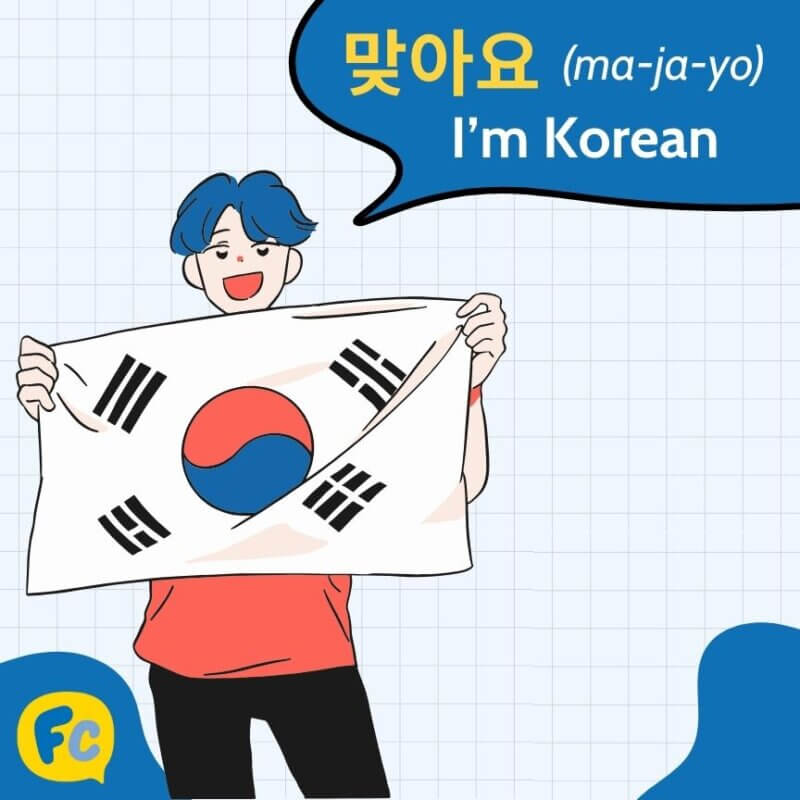
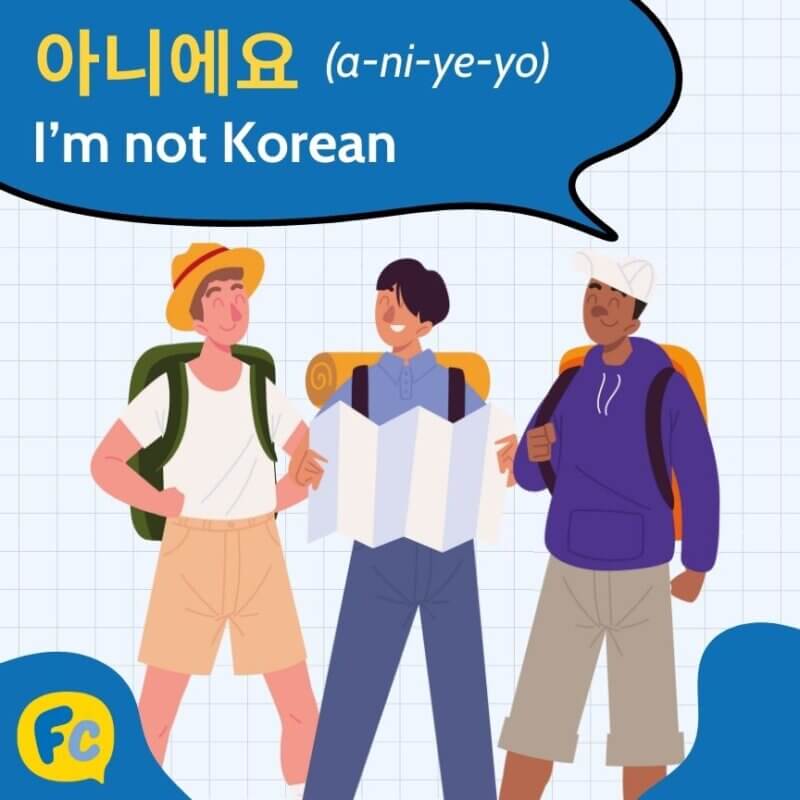
| Korean | Meaning |
|---|---|
| 아니에요 (a-ni-ye-yo) | No [I’m not] |
| 맞아요 (ma-ja-yo) | That’s right! |
✨ Now that you’ve learned the two different No’s and how to differentiate 아니요 (a-ni-ye-yo) and 아니에요 (a-ni-ye-yo).
Let’s move on to understanding how we can decline or reject a question politely.
No in Korean | Alternative Ways to Say No
🔎 English is a pretty straightforward language where people value clear communication. On the contrary, Koreans use indirect communication in many situations, particularly, when rejecting something.
Koreans often would add an expression before or after the rejection
so it doesn’t sound so blunt.
괜찮아요 (gwaen-chan-a-yo) – it’s okay
괜찮아요 (gwaen-chan-a-yo) is a popular term you will hear when someone is declining or rejecting.
Here is an example dialogue:
여기 앉을래요?
(yeo-gi-ahn-jul-le-yo)아니요 괜찮아요
(a-ni-yo gwaen-chan-a-yo)죄송하지만 (joe-song-ha-ji-man) – I apologize but..
Another way you can reject is by saying 죄송하지만 (joe-song-ha-ji-man). By apologizing there is less impact to the rejection.
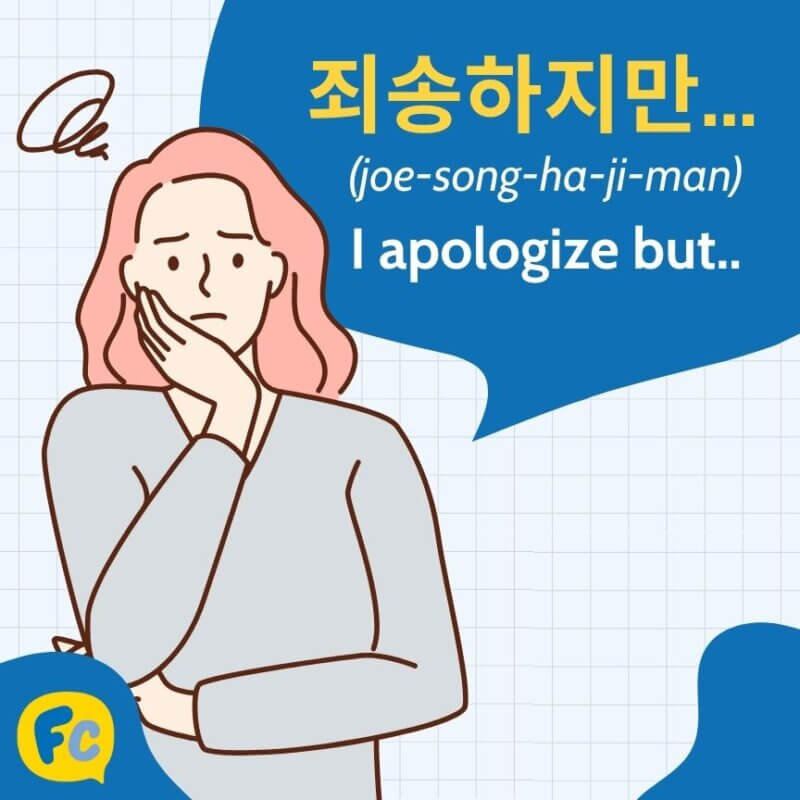
내일 올 거예요?
(ne-yil-ol-ge-ye-yo)죄송하지만 못가요
(joe-song-ha-ji-man mot-ga-yo)다음 기회에 (da-um-gi-hwe-e) – maybe next time
다음 기회에 (maybe next time) is used when you don’t want to sound too – mean and give room for next time.

같이 점심 먹을래요?
(ga-chi jeom-sim mo-gul-le-yo)죄송하지만 다음 기회에 같이 먹어요.
(joe-song-ha-ji-man da-um-gi-hwe-e ga-chi mo-go-yo)📖 Now that you have learned both the formal and informal ways of saying no it’s time to put it into practice. Try sitting in a cafe next time and eavesdrop on daily conversations to discover how Koreans use No in different situations.
Of course, practicing is always better than just listening. So the next time you are out and about in Korea, get more involved in conversations. Take notes and try out what you’ve learned from this lesson.
USEFUL VOCABULARY
👇 We should have you pretty well covered with the following vocabulary and phrases:
| Korean | Transliteration | English |
|---|---|---|
| 아닙니다 | a-nip-ni-da | No (most formal) |
| 아니요 | a-ni-yo | No (polite form) |
| 아니 | a-ni | No (casual form) |
| 아니에요 | a-ni-e-yo | It is not / not the case |
| 괜찮아요 | gwaen-chan-a-yo | It’s okay |
| 죄송하지만 | joe-song-ha-ji-man | I apologize but… |
| 다음 기회에 | da-eum gi-hwe-e | Maybe next time |
| 안돼요 | ahn-de-yo | Cannot |
| 할 수 없어요 | hal su eop-sso-yeo | I can’t do it |
| 못해요 | mot-hae-yo | I can’t |
✨ Remember that there is no better way to learn a language than immersing yourself in the culture.
To learn more about Korean culture, check out this!

29 Korean Jokes to Sound Like a Native
You want to impress your Korean friends by showing that your language skills have improved? It’s time to learn some Korean jokes! Here are 29 for you.
If you enjoyed this article, make sure to check out the following posts:
👉 Different Ways to Say No in Spanish
👉 Rejection in the Country of Harmony: No in Japanese
No in Korean | FAQ
How do I say no in Korean?
The standard form of ‘No’ in Korean appropriate for most situations is 아니요 (a-ni-yo)
What are some ways to say cannot in Korean?
안돼요 (ahn-de-yo)
할 수 없어요 (Hal su oep-sso-yeo)
How do you say I can’t do it in Korean?
못해요 (mot-hae-yo)
What is a popular way to say No in Korean?
아뇨 (ah-nyo)
This is a short form of 아니요 (an-ni-yo)
Want More From LTL?
FANCY LEARNING KOREAN? Check out our online Korean courses here.
We offer a 7-day free trial to all online students where you can study Korean 24/7.
Want to study Korean in Korea instead? Our Korean courses in Seoul can either be taken in small groups of no more than 5 students or individually for a more tailored experience.
We even offer incredible homestay experiences in Seoul too.
It doesn’t end here, sign up to the newsletter for even more free resources and news from LTL ⬇️











